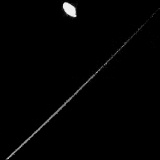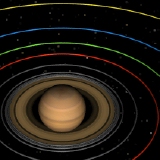 Voyager 1 image of Calypso. |
|
| CALYPSO - MOON OF SATURN | |
| Calypso was a sea nymph and the daughter of Atlas. When Odysseus was shipwrecked on the island of Ogygia Calypso took a liking to him and promised him immortality if he would stay with her. Odysseus refused and wanted to go home but she kept him there anyway. Eventually Zeus intervened and Odysseus was set free. Calypso was discovered by Brad Smith and his co-workers on the Voyager mission in 1981. | |
| Orbit | |
| Calypso orbits 294,660 kilometres from Saturn and follows a circular path in Tethys' trailing Lagrange point, 60o behind Tethys. Calypso, and Telesto in the leading Lagrange point, are Tethys' Trojan moons. | |
 The orbits of Enceladus, Tethys, Telesto, Calypso, Dione, Helene, and Rhea. |
|
| Physical properties | |
| Calypso is small and slightly elongated, measuring 34 x 22 kilometres. The mass and density of Calypso are unknown. Calypso is probably the captured remnant of an asteroid collision and may have the same parent body. On the same orbital path as Tethys, Calypso ended up at one of the stable 60o. Lagrange points marked out by an equilateral triangle. | |
| Interior | |
| The interior of Calypso is unknown. | |
| Magnetic field | |
| No magnetic field has been detected. | |
| Atmosphere | |
| No atmosphere has been detected. | |
| Surface | |
| The best image of Calypso reveals no surface detail. It has an albedo of 0.6. | |
|
|
|